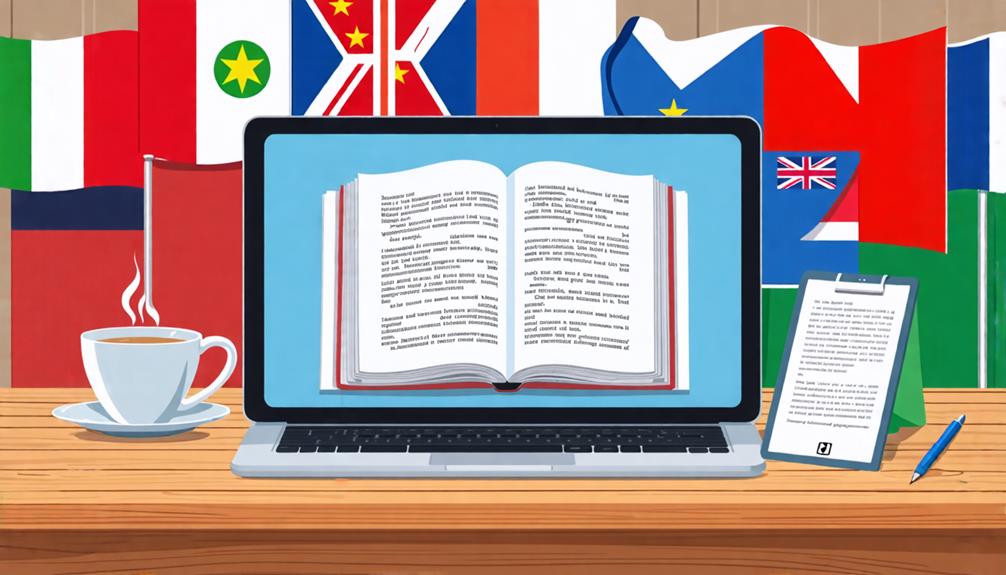Translating e-books for self-published authors involves converting an original e-book into a different language to target a specific market. To implement this side hustle, authors should follow a strategic process.
First, identify the target language and market. Research the demand for e-books in the chosen language and understand the cultural nuances of the target audience. This includes recognizing local preferences, idioms, and expressions to ensure the translation is accurate and engaging.
Next, prepare the e-book for translation. Format the original text into a translation-friendly file and review the content for any cultural or language-specific references that may require adaptation.
Choose a translation method: hire a professional translator, use machine translation software, or work with a translation agency. Each option has its pros and cons, and the choice depends on the author's budget, time constraints, and desired level of quality.
Ensure that the translated e-book is edited and proofread to maintain its original quality. This step is crucial to prevent errors, inconsistencies, and cultural misunderstandings.
Finally, publish and distribute the translated e-book through various channels, such as online retailers, e-book platforms, or the author's website. Utilize marketing strategies to reach the target audience, including social media, email marketing, and book promotions.
Key considerations for self-published authors when translating their e-books include budgeting, quality control, and cultural adaptation. By prioritizing these factors, authors can successfully expand their audience reach and increase their global market potential.
Why Translate Your E-book
As an e-book author looking to augment your side hustle, translating your work into multiple languages can vastly expand your reader base and increase earnings.
By doing so, you can tap into the global market, reaching readers who may be eager for literature in their native language. This move not only boosts your online presence but also positions you as a versatile author who caters to a diverse audience.
In the digital age, readers from varied linguistic backgrounds are seeking literature that resonates with their experiences. By offering your e-book in multiple languages, you can fill this demand gap and establish a strong, global online presence, a crucial element in growing a successful side hustle.
Moreover, translation opens the door to exploring different literary genres and styles, enabling you to diversify your offerings and attract an even broader readership.
Choosing the Right Translator
When it comes to translating your e-book, the expertise of the translator is paramount to guarantee that the nuances of your original text are accurately conveyed in the target language.
To secure high-quality translation, evaluating the translator's credentials is essential.
A translator with the right qualifications, experience, and cultural knowledge can make all the difference in capturing the tone, style, and context of your e-book, ultimately leading to a successful translation.
Translator Expertise Matters
Selecting a translator with specialized expertise in a specific genre or subject matter is crucial for side hustlers looking to expand their audience through e-book translation.
Translator specialization ensures that the translated e-book meets the highest standards of quality and fidelity to the original text, which is essential for building credibility and trust with readers. A translator with domain-specific knowledge can accurately convey the author's intended meaning and tone, guaranteeing that the translation is not only linguistically correct but also culturally relevant.
Language nuances, such as idiomatic expressions, colloquialisms, and figurative language, can be particularly challenging to translate. A translator with expertise in the relevant genre or subject matter can navigate these complexities with ease, producing a translation that is both accurate and engaging.
Additionally, a specialized translator can also identify and adapt cultural references, guaranteeing that the translation is tailored to the target audience's unique cultural context. By choosing a translator with the right expertise, side hustlers can guarantee that their e-book is translated to the highest standards, maintaining its original intent and resonance, and increasing its potential for success in new markets.
Assessing Translator Credentials
Evaluating a translator's credentials is crucial when outsourcing translation work for a side hustle, such as translating e-books, articles, or website content. To ensure high-quality translations that meet client expectations, it's essential to assess a translator's qualifications, language proficiency, and experience in translating texts within the relevant genre or subject matter.
Key factors to consider when evaluating a translator's credentials for a side hustle include:
- Relevant certifications and qualifications: Look for certifications from reputable organizations, such as the American Translators Association (ATA) or the International Association of Professional Translators and Interpreters (IAPTI).
- Language proficiency: Confirm the translator is fluent in both the source and target languages, with a deep understanding of cultural nuances and linguistic complexities.
Understanding Translation Costs
As a side hustler considering ebook translation as an additional income stream, it's crucial to determine the actual costs involved in translating an ebook and what factors contribute to the overall expense. A realistic translation budget can help you maximize profits and successfully cater to a global audience.
Translation costs can vary greatly, depending on key factors, including language pair, translator expertise and rates, and ebook length and complexity.
To estimate costs accurately, consider the translator's fees, editing and proofreading expenses, and potential formatting changes. With the standard industry metric of cost per word ranging from $0.05 to $0.25, translating a 50,000-word ebook from English to Spanish can cost between $2,500 and $12,500. Additionally, translators might charge hourly or flat fees for services like editing or formatting.
Preparing Your E-book for Translation
Preparing Your Side Hustle E-book for Global Reach
As a side hustler, taking your e-book to a global audience requires more than just translation. It demands meticulous preparation of your original manuscript to ensure that your message resonates with readers from diverse cultural backgrounds. To guarantee a high-quality translation, you must consider cultural nuances and develop localization strategies that cater to your target audience.
Before submitting your side hustle e-book for translation, review and edit the content with the following considerations in mind:
- Cultural references: Are there cultural-specific terms, phrases, or concepts that may not be familiar to your target audience, potentially hindering the success of your side hustle?
- Idiomatic expressions: Are there idiomatic expressions or colloquialisms that may not translate literally, impacting the clarity of your side hustle message?
Translation File Formats Explained
Preparing your side hustle e-book for translation requires careful consideration of file formats to ensure a smooth and efficient process. The compatibility of files with translation software and agencies is crucial in determining the success of the translation workflow. The following table highlights the most commonly used file formats in e-book translation, their compatibility with popular translation software, and the recommended file format for efficient translation.
| File Format | Compatibility with Translation Software |
|---|---|
| Microsoft Word (.docx) | High |
| Adobe InDesign (.indd) | Medium |
| HTML (.html) | High |
| PDF (.pdf) | Low |
Using Microsoft Word (.docx) or HTML (.html) files for translation is recommended, as they offer high compatibility with most translation software and can be easily imported and exported. This allows side hustlers to focus on reviewing and refining the translated content, rather than resolving technical issues. By prioritizing file compatibility, side hustlers can guarantee a successful and efficient e-book translation process, enabling them to reach a wider audience and grow their side hustle.
Managing the Translation Process
Managing the translation process for self-published e-books as a side hustle requires strategic planning, effective communication, and technical oversight to ensure high-quality translations and timely delivery. To balance translation work with other commitments, prioritize effective project management to meet translation deadlines and keep stakeholders informed.
To ensure a smooth translation process, focus on the following key elements:
- Streamlined communication: Establish open communication channels with clients and translation teams to address issues promptly, even on a part-time schedule.
- Well-defined project scope: Clearly outline project scope, including content to be translated, timelines, and budget, to avoid misunderstandings and ensure efficient use of limited side hustle time.
Ensuring Translation Quality Control
As self-published authors navigate the complex process of translating their e-books, ensuring quality control becomes paramount to maintain artistic integrity and reader satisfaction.
A robust quality control framework should comprise a rigorous translator evaluation process, the creation of a thorough style guide, and meticulous content quality checks to guarantee accuracy, consistency, and cultural relevance.
Translator Evaluation Process
Evaluating Freelance Translators for Your Side Hustle
As a side hustler offering translation services, it's crucial to have a thorough translator evaluation process in place to ensure high-quality work. This process assesses a translator's language proficiency, subject matter expertise, and experience in translating texts similar to the projects you'll be working on.
To secure high-quality translations and grow your side hustle, consider the following essential translator qualifications:
- Language expertise: A deep understanding of the source and target languages, including their respective grammar, syntax, idioms, and cultural context.
- Subject matter knowledge: Familiarity with the industries or subjects you'll be working with, assuring the translator is equipped to handle technical vocabulary and specialized concepts.
Throughout the evaluation process, effective translator communication is critical. This includes evaluating their ability to clarify translation queries, provide context when needed, and engage in a collaborative dialogue to guarantee a high-quality translation.
Style Guide Creation
Creating a comprehensive style guide is crucial for freelancers and side hustlers offering translation services, as it allows them to maintain consistency and quality across all client projects. A well-structured style guide provides the necessary framework for navigating linguistic nuances, cultural references, and stylistic preferences, ensuring that translated content meets client expectations and resonates with target audiences.
Essential components of a style guide for side hustlers include defining tone, voice, and language usage, as well as specifying formatting and punctuation conventions. Consistency in terminology, grammar, and syntax is also vital to delivering high-quality translations.
A detailed style guide should address cultural sensitivities, idiomatic expressions, and regional variations, providing freelancers with the necessary context to produce polished translations that meet client standards.
Content Quality Checks
Implementing rigorous content quality checks is crucial for side hustlers offering translation services to ensure high-quality deliverables. This step allows translators to verify the accuracy, coherence, and cultural relevance of the translated content, guaranteeing that the final product meets the desired standards and maintains their professional reputation.
Effective content quality checks involve a combination of proofreading strategies and quality assurance measures.
The following aspects should be carefully evaluated:
- Cultural sensitivity: Ensuring that cultural references, idioms, and expressions are accurately translated and adapted for the target audience.
- Linguistic accuracy: Verifying that the translation is free from grammatical, punctuation, and spelling errors.
Cultural Considerations in Translation
Translating side hustle e-books for a global audience requires more than just linguistic expertise.
Conveying the nuances of cultural context is crucial to connecting with readers from diverse backgrounds. Cultural norms, values, and sensitivities play a significant role in determining the effectiveness of a translation. Idiomatic expressions and colloquialisms that resonate with one audience may fall flat or even offend another.
A skilled translator must be well-versed in the cultural context of the target audience and adapt the text accordingly. This involves researching the target culture, consulting with native speakers, and considering local customs and preferences.
A culturally sensitive translation is essential to conveying the author's message and engaging readers. In side hustle e-book translation, striking a balance between linguistic accuracy, cultural awareness, and literary flair is key to success.
Formatting Your Translated E-book
As the translation process comes to a close, attention turns to the critical task of formatting your e-book for a global audience.
A well-formatted translated e-book requires careful consideration of the file preparation, font, and size, as well as the internal layout to guarantee a seamless reading experience.
Preparing Your E-book File
Preparing Your E-book File for a Side Hustle
One essential step in self-publishing an e-book as a side hustle involves formatting the file to guarantee that the text is accurately rendered and easily readable on various digital platforms. Proper file organization is critical to ascertain that all elements, including text, images, and tables, are correctly positioned and displayed.
Furthermore, document compatibility is fundamental to prevent formatting errors and ascertain that the e-book can be opened and read on different devices and e-readers, expanding the potential audience and sales.
To achieve this, consider the following key aspects:
- Clear file structure: Organize files into clear folders and subfolders, making it easy to locate and access specific elements, allowing for efficient updates and future revisions.
- Standardized formatting: Use consistent formatting styles throughout the e-book, including font, spacing, and margins, to maintain a cohesive look and feel that enhances the reader experience.
Choosing Font and Size
Choosing Font and Size for Your Side Hustle E-Book
With a well-organized file structure and standardized formatting in place, selecting a suitable font and size becomes the next important consideration in creating a visually appealing and readable e-book that effectively communicates your side hustle knowledge to potential clients.
Font readability is a vital factor, as it guarantees that the text is clear and easy to read on various devices. Size consistency is also essential, as it maintains a professional look and prevents distractions. The following table outlines some recommended font and size combinations:
| Font Family | Size (Points) |
|---|---|
| Serif (e.g., Garamond) | 10-12 |
| Sans-Serif (e.g., Arial) | 9-11 |
| Script (e.g., Lobster) | 12-14 |
| Headings (e.g., Chapter Titles) | 14-18 |
When choosing a font and size for your side hustle e-book, consider your target audience and brand identity. For instance, an online course e-book may use a larger font size for instructional purposes, while a consulting e-book may use a smaller font. Confirm that your selection is consistent throughout the book to maintain a professional finish. Remember, the goal is to create a clear, readable, and engaging e-book that showcases your expertise and enhances the reader's experience.
Designing Internal Layout
Crafting a well-designed internal layout for your side hustle's digital products, such as eBooks, guides, or courses, is crucial for capturing the reader's attention, conveying valuable information, and ultimately enhancing their learning experience. A consistent layout reinforces the visual hierarchy of the content, directing the reader's eye through the text and emphasizing key takeaways.
To create an effective internal layout for your side hustle's digital offerings, consider the following points:
- Use clear headings and subheadings to establish a logical structure and define the hierarchy of information, making it easier for readers to navigate and understand complex concepts.
- Balance text and white space to avoid overwhelming the reader and enhance readability, allowing them to focus on the most critical elements of your side hustle's expertise.
Marketing Your Translated E-book
Side Hustle: Amplify Your Translated E-book's Reach
Translate an e-book and take the first step; market it effectively to reach new audiences. As a side hustler, leveraging the right marketing strategies will help your e-book go global.
Targeting New Markets with Multilingual Strategies
| Marketing Channel | Description |
|---|---|
| Social Media | Utilize platforms like Facebook, Twitter, and LinkedIn to connect with native speakers. Create separate language accounts for enhanced engagement. |
| Online Communities | Engage with Goodreads, online forums, and groups where readers discuss books in their native language. Share updates, answer questions, and garner feedback. |
| Email Marketing | Develop an email list of subscribers interested in your translated e-book. Send targeted newsletters with updates, promotions, and behind-the-scenes content. |
Conclusion
Translation serves as a master key, opening the doors to a global literary market.
By harnessing the power of language, self-published authors can transcend cultural boundaries, their works resonating with diverse audiences.
A symphony of words, carefully crafted and culturally adapted, guarantees the integrity of the original message.
As the world becomes a smaller stage, translation takes center stage, spotlighting authors and their works for a global audience, thereby amplifying their literary impact.

















































0
View comments